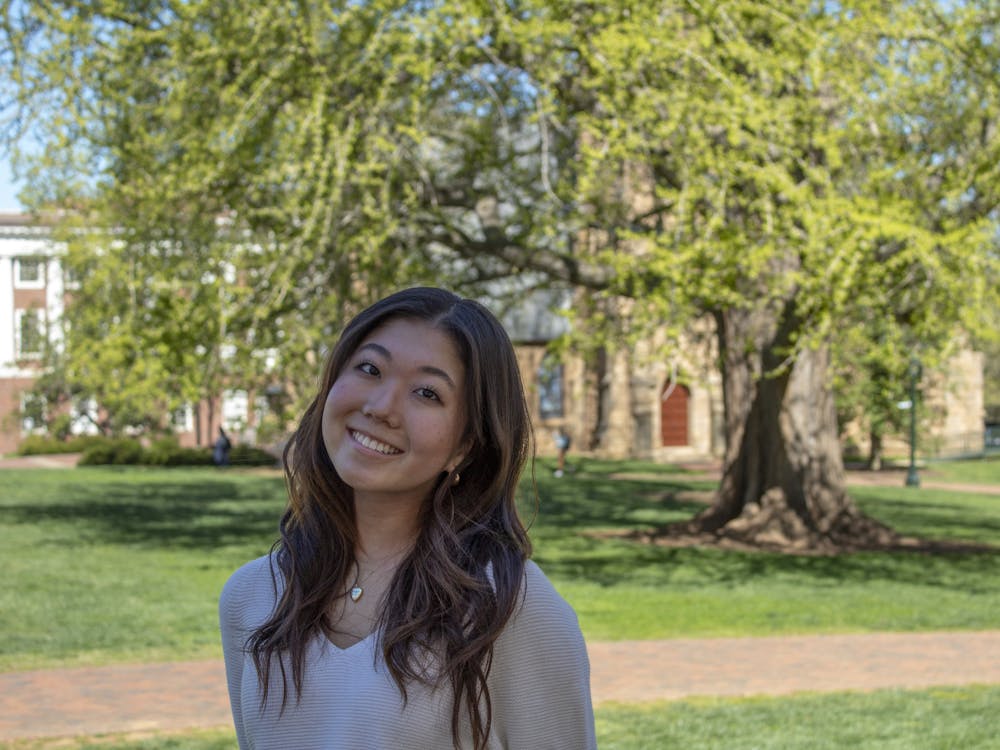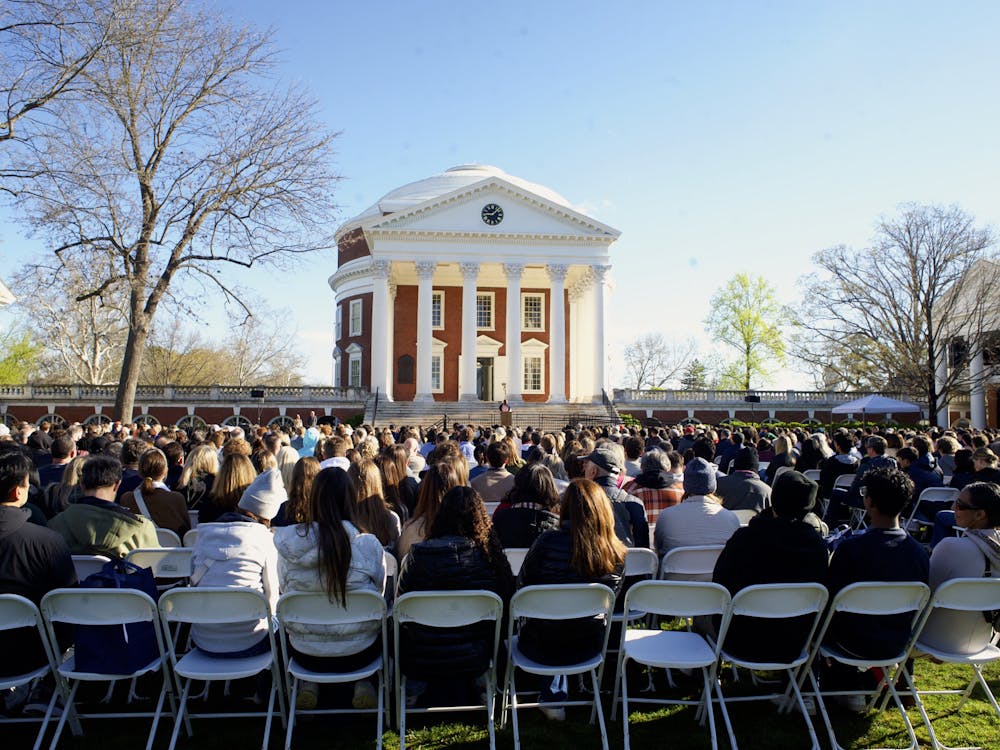Try to imagine a Cavalier football game without its marching band. Cav Man demolishes his computer-animated enemy and gallops the field in triumph, cheerleaders back-flip and somersault, football players charge through smoke to a roaring crowd. But where is the “Good Ol’ Song?” The energizing rally tunes? The glory? Still present, perhaps, but less palpable without the boom of Cavalier brass and drums.
It may be difficult for today’s undergraduates to imagine any band routine other than the ranks of caped and feather-capped musicians weaving intricate formations across the field. But the Cavalier Marching Band is young — this year marks only its fifth anniversary.
The original athletic band started in the 1920s and later closed because of difficulties in 1962, according to the band’s Web site. Its place was filled by a student pep band from 1969 until 2003, when a $1.5 million donation from Carl and Hunter Smith allowed for the revival of the official marching band under Director of Bands William Pease.
The new band’s inception did not escape controversy: The pep band it unseated had been in place for more than three decades, and some University students were upset when the pep band lost the right to play at games once the marching band stepped in. Pease himself said one of the most common questions he was asked in early press interviews was how he felt about the replacement.
His response today remains what it was then: “I was just hired to put a marching band together ... [and didn’t] make the decision.” His feelings toward the Pep Band? “I support students,” he said. “Anybody that provides services to the school ... whether they are choral kids or string kids or band kids ... you hope they do well.”
Since the inception of the marching band, the pep band has continued to perform at a host of community and club sporting events, and pep band member Ellen Reifler noted that the pep band is trying to initiate communication with the athletic department to reach an agreement about being allowed to play at various events.
For now, though, music at football games is provided by the Cavalier Marching Band, which made its debut Sept. 11, 2004, when Pease introduced the band at a packed home game. He called his experiences during the past five years “amazing,” attributing the band’s success not to his own leadership, but the band’s overall cohesiveness.
“It’s not really about one person,” he said, noting that the band is a team effort with many people involved.
By “a lot of people,” Pease meant 260 student members, both musicians and others, who collaborate with the band’s professional supervisors and adult volunteers. He said that number has grown more than he expected, noting the band is probably close to its maximum possible size.
Assoc. Director of Bands Andrew Koch handles the logistics of moving the hundreds of students and their instruments in unison over a confined space. He said the band is currently “making provisions” to accommodate its rapid expansion.
Band members themselves must practice rigorously to ensure that Koch’s logistics flow smoothly at every home and away game, every pre-game and halftime show. A week before Move-In Day every August, Koch said, the band leaps into the new game season with three rehearsals a day, Saturday through Friday.
Third-year College student Katie Croghan, who plays clarinet, said once school starts, musicians commit to rehearsing three times a week before home performances and twice a week before away performances. Add to those rehearsals the actual game days and the long hours of traveling to away games, and the sacrifice of time and energy required of band participants becomes evident.
Drumline instructor Patrick Zampetti finds the commitment inspiring.
“It’s really refreshing ... to see the enthusiasm that goes into even rehearsals,” he said.
He added that drumline members must put in their own additional practice time.
“Keeping time is the heart and soul of the band,” he said, and requires a high level of dedication from every drummer.
But Croghan, Koch, Pease and Zampetti all emphasized the fulfillment that accompanies such a time commitment. Band membership is voluntary; Koch said it is not a requirement for music majors, nor does it satisfy music majors’ ensemble requirement.
The marching band counts as a two-credit elective course of which students deliberately choose to be a part.
“It’s different when you’re doing it because you have to,” Koch said of past band experiences at other colleges. But here, members are doing it “strictly for the love of ... band and camaraderie,” he said.
Croghan, too, affirmed that the band is fueled by motivation rather than obligation.
“People are there because they want to do it ... because they want to make it better and have a good time,” she said.
Because of the band’s elective status, only a few of its 260 student members are music majors, Croghan said. The rest cover a vibrant spectrum of interests and activities — and represent roughly 80 different academic concentrations, Koch said.
“It’s a really good group of people ... from all over,” Croghan said. “I have friends in the [Engineering] School, friends in the [Architecture] School [and] everybody there is so intelligent.”
The chance to interact with such a diverse group of student musicians daily is one of the main factors that drew Pease to take the job as the director of bands.
“I didn’t think about [the decision] so much as starting a band ... [as wanting] to work with really bright students,” Pease said. “I learn a lot from them.”
Pease has previously taught at both high school and college levels, and as director of bands at the University, he oversees the Cavalier Marching Band, Wind Ensemble and Men’s Basketball Band, in addition to teaching Wind Ensemble.
Pease said he tries to get to know each student involved in band activities and enjoys watching them develop and pursue their diverse range of talents. One band student, for example, is currently conducting cancer research.
“He tries just as hard to get a B-flat as he does to [complete] his cancer research,” Pease said.
Koch and Zampetti share Pease’s respect for the students’ talent — Zampetti once taught Pease himself — and all three leaders credited the current marching band’s structure for translating that respect into a high level of student governance. In addition to regular drill leaders and section members, Koch said the marching band has about 30 student staff members to fulfill various duties, such as equipment set-up, banquet preparations and Web updates.
Zampetti noted the ability of student leaders to connect directors and musicians — “to transition the learning into something kids can really relate to.”
Within the drumline, Zampetti relies heavily upon Engineering graduate student Michael Purvis to help lead and fill his place when necessary.
Just as Pease relies on students for current leadership, he also looks to them for future development.
“I try to sit down with [them] and find out what they like about the band, what ... they think our identity is, [and] where they should go,” he said.
If anything, he said he hopes to keep channeling more power to the students who already lead each other on and off the field.
Koch and Zampetti agreed about the need to maintain student leadership and focus on the importance of the group as a whole. Everything the marching band does — from rehearsing long hours to rushing in unison through the Scott Stadium tunnel — is “based on being part of a team,” Zampetti said.




